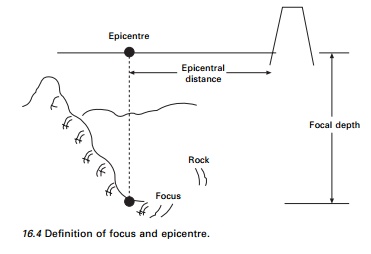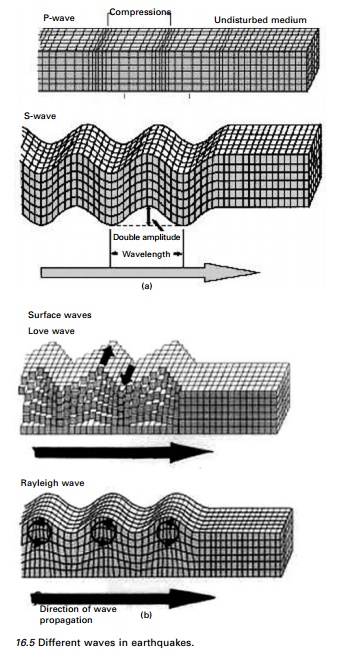Chapter: Civil : Structural dynamics of earthquake engineering
Seismic waves

Seismic waves
As the first occurrence
of an earthquake, seismic waves are generated that propagate through the
EarthŌĆÖs crust. The position of the fault plane where seismic motion originates
is called the ŌĆśfocusŌĆÖ (see Fig. 16.4) or hypo-centre.
The point in the
EarthŌĆÖs surface directly above the focus is the epicentre. The focal
distance and the epicentral distance are the distance from the focus and
the epicentre respectively to the point of observed ground motion. As seen
before, depending upon the depth of the focus, the earthquake is classified as shallow,
intermediate or deep.
Earthquake forces may occur at any depth from near
the surface to a depth of 700 km. When the focal depth of an earthquake is less
than 60 km, the ground motion is localized and the earthquake is called a
normal or shallow focus earthquake. If the focal depth is between
185 and 300 km, the earthquake is felt over a wide area and it is called
a deep focus earthquake. When the focal depth is between 60 and 180 km
it is called an intermediate earthquake. Sometimes, associated with
volcanic eruptions or subterranean movement of

magma the major problem
activity observed is of tectonic origin. Shallow focus earthquakes are devasting.
All known earthquakes to date in California have been the shallow focus
type.
Two basic types of
waves (body waves and surface waves) make up the shaking and cause damage in an
earthquake. These waves are similar in many important ways to the familiar
waves in air, water and gelatin. Of these, two propagate within a body of solid
rock.
1 Body waves
P wave (primary wave)
The faster of these
body waves is appropriately called a P wave. Its motion is the same as that of
a sound wave in that, as it spreads out, it alternately pushes (compressive)
and pulls (dilates) the rock (see Fig. 16.5). These P waves, like sound waves,
are able to travel through both solid rock such as granite mountains, liquid
material such as volcanic magma or the water of the oceans. They travel with a
velocity of approximately 350 m/s and are the first to reach the surface.
Usually their speeds are 330 m/s in air, 1450 m/s in water and 5000 m/s in
granite. These waves are less destructive than S waves because of their low
amplitude.
2 S wave (secondary wave)
The S wave is also referred to as the shear or
transverse wave. It propagates in a direction perpendicular to vibration (see
Fig. 16.5). Thus at the ground surface S waves can produce both vertical and
horizontal motions. S waves cannot propagate in the liquid parts of the Earth
such as oceans and their

amplitude is
significantly reduced in liquefied soil. Their speed is about 60% of that of P
wave in a given material. Their amplitudes are several times larger than P
waves.
The actual speed of P
and S seismic waves depends on the density and elastic properties of the rocks
and soil through which they pass. In most earthquakes, P waves are felt first.
The effect is similar to a seismic boom that bumps and rattles windows. Some
seconds later the S waves arrive with their significant component of side to
side motion so that ground shaking is both vertical and horizontal. This wave
cause most damage to structures.
The speed of P and S waves is given in terms of
density of elastic material and elastic modulus. The propagation velocity of a
P wave is Vp and of an S waves is Vs in
elastic materials. The velocities are frequency independent and are expressed
as

where E = modulus of elasticity, G = modulus of
rigidity and Žü = density.
In all
materials Vp > Vs. Therefore P waves arrive first to the surface.
Although S waves travel more slowly than P waves,
they transmit more energy and are most effective in inflicting damage on structures.
Surface
waves in an earthquake can be divided into two
types:
’éĢ L (Love)
wave. The L wave has essentially the same motion as that of an S wave, i.e. it has no vertical displacement.
It moves the ground side to side in a
horizontal plan parallel with EarthŌĆÖs surface but at right angles to the direction of propagation (see Fig.
16.5). It travels faster than an R wave,
with 90% of S wave velocity.
’éĢ R (Rayleigh) wave.
The second type of surface wave is like rolling ocean waves, in that the pieces
of rocks disturbed by Rayleigh waves move both vertically and horizontally in a
vertical plane pointed in the direction in which the waves are travelling. Each
piece of rock moves in an ellipse as the wave passes. The velocity of an R wave
is 70% that of an S wave and has been asserted to be visible during an
earthquake in open space. Cars move up and down with these waves.
Surface waves travel more slowly than body waves and
of the two surface waves, Love waves generally travel faster than Rayleigh
waves. Thus as the waves radiate outwards from the earthquake source into the
rocks of the EarthŌĆÖs crust, the different types of waves separate out from the
another in a predictable pattern.
When P waves and S
waves reach the surface of the ground, most of the energy is reflected back
into the crust, so that the surface is affected almost simultaneously by upward
and downward moving waves. For these reasons considerable amplifications of
shaking typically occur near the surface, sometimes doubling the amplitude of
the upcoming waves.
The velocity differential between P waves and S
waves can be used to locate the epicentre and focus of the earthquake. The time
interval between the arrival of a P wave Tp and an S wave Ts
to a seismographic station is called the duration of preliminary tremors and is
expressed as
Tsp =
[(1/Vs) ŌĆ' (1/V p)] d 16.3
where Tsp = Ts ŌĆ'
Tp and d is the distance travelled by the waves.
The quantity Tsp
is determined from seismogram as the difference between the initial time of the
S wave and P wave. The focal depth d can be determined from the above
equation. The location of the focus and epicentre can be ascertained if d
is determined from three or more seismograph stations (see Fig. 16.6).
Related Topics